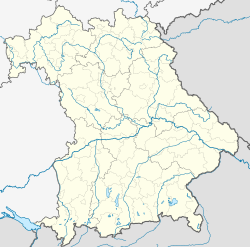world.wikisort.org - Germany
Kranzberg is a municipality in the district of Freising in Bavaria in Germany.

Kranzberg | |
|---|---|
Municipality | |
 Church of Saint Quirinus in Kranzberg | |
 Coat of arms | |
Location of Kranzberg within Freising district  | |
 Kranzberg  Kranzberg | |
| Coordinates: 48°24′N 11°37′E | |
| Country | Germany |
| State | Bavaria |
| Admin. region | Oberbayern |
| District | Freising |
| Government | |
| • Mayor (2020–26) | Hermann Hammerl[1] (FW) |
| Area | |
| • Total | 39.50 km2 (15.25 sq mi) |
| Elevation | 483 m (1,585 ft) |
| Population (2020-12-31)[2] | |
| • Total | 4,214 |
| • Density | 110/km2 (280/sq mi) |
| Time zone | UTC+01:00 (CET) |
| • Summer (DST) | UTC+02:00 (CEST) |
| Postal codes | 85402 |
| Dialling codes | 08166 |
| Vehicle registration | FS |
| Website | www.kranzberg.de |
At Bernstorf, a part within the municipality of Kranzberg, a Bronze Age fortification was found in 1904 by local historian Josef Wenzl. It was dated at around 1360 B.C. and is the largest known Bronze Age settlement north of the Alps. Most significant were finds of gold and amber objects which contained writings in Mycenaean Greek Linear B. These objects were found by amateur archaeologists Manfred Moosauer and Traudl Bachmair in 1998. The objects are now kept in the national Bavarian archaeological collection in Munich.[3]
References
- Liste der ersten Bürgermeister/Oberbürgermeister in kreisangehörigen Gemeinden, Bayerisches Landesamt für Statistik, 15 July 2021.
- "Tabellenblatt "Daten 2", Statistischer Bericht A1200C 202041 Einwohnerzahlen der Gemeinden, Kreise und Regierungsbezirke". Bayerisches Landesamt für Statistik (in German). June 2021.
- Karl Heinz Rieder und Rupert Gephard, Zwei Bronzezeitliche Bernsteinobjekte mit Bild- und Schriftzeichen aus Bernstorf (Lkr. Freising). Germania 80, 115-133
На других языках
- [en] Kranzberg
[ru] Кранцберг
Кранцберг (нем. Kranzberg) — коммуна в Германии, в земле Бавария.Текст в блоке "Читать" взят с сайта "Википедия" и доступен по лицензии Creative Commons Attribution-ShareAlike; в отдельных случаях могут действовать дополнительные условия.
Другой контент может иметь иную лицензию. Перед использованием материалов сайта WikiSort.org внимательно изучите правила лицензирования конкретных элементов наполнения сайта.
Другой контент может иметь иную лицензию. Перед использованием материалов сайта WikiSort.org внимательно изучите правила лицензирования конкретных элементов наполнения сайта.
2019-2025
WikiSort.org - проект по пересортировке и дополнению контента Википедии
WikiSort.org - проект по пересортировке и дополнению контента Википедии
